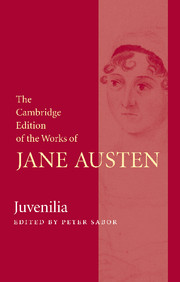Book contents
- Frontmatter
- Contents
- General editor’s preface
- Acknowledgements
- Chronology
- Introduction
- Note on the text
- Volume the First
- Volume the Second
- Volume the Third
- Corrections and emendations
- Appendix A The History of England: facsimile
- Appendix B Marginalia in Oliver Goldsmith’s The History of England, from the Earliest Times to the Death of George II
- Appendix C Marginalia in Vicesimus Knox’s Elegant Extracts . . . in Prose
- Appendix D Sophia Sentiment’s letter in The Loiterer, 28 March 1789
- Appendix E Continuations of ‘Evelyn’ and ‘Catharine’ by James Edward Austen and Anna Lefroy
- Abbreviations
- Explanatory Notes
Appendix B - Marginalia in Oliver Goldsmith’s The History of England, from the Earliest Times to the Death of George II
Published online by Cambridge University Press: 18 December 2020
- Frontmatter
- Contents
- General editor’s preface
- Acknowledgements
- Chronology
- Introduction
- Note on the text
- Volume the First
- Volume the Second
- Volume the Third
- Corrections and emendations
- Appendix A The History of England: facsimile
- Appendix B Marginalia in Oliver Goldsmith’s The History of England, from the Earliest Times to the Death of George II
- Appendix C Marginalia in Vicesimus Knox’s Elegant Extracts . . . in Prose
- Appendix D Sophia Sentiment’s letter in The Loiterer, 28 March 1789
- Appendix E Continuations of ‘Evelyn’ and ‘Catharine’ by James Edward Austen and Anna Lefroy
- Abbreviations
- Explanatory Notes
Summary
On 26 November 1791, Jane Austen dedicated her ‘History of England’ to her sister Cassandra. Before then, in all likelihood, and probably earlier in 1791, she wrote over a hundred marginal comments on a copy of Oliver Goldsmith's four-volume History of England. All four volumes bear the signature of her brother, ‘James Austen Steventon’, on the paste-downor front free endpaper, although that in volume three, seen by David Gilson, has since been covered during rebinding. None of the volumes is signed by Austen, but Gilson notes that the front free endpaper of volume four has been roughly removed: perhaps because it contained a signature desired by an autograph collector.
Either during Austen's lifetime or after her death, the volumes were bequeathed to the son of the first owner, James Edward Austen-Leigh (1798–1874). In 1919, they were in the possession of Mary Augusta Austen-Leigh (1838–1922), James Edward’s daughter, who inserted a note to this effect in the final volume and imperfectly transcribed ten of JA's marginal comments. A year later, she included these transcriptions in her Personal Aspects of Jane Austen (1920). After her death in 1922, the volumes were passed down in the Austen-Leigh family, from Laurence Impey (nephew of Richard Arthur Austen-Leigh) to his daughter Evelyn Fowle, and his granddaughter Katharine Beaumont, the present owner.
Austen's marginalia are concentrated almost entirely in the third and fourth volumes of Goldsmith's History. The first volume contains a summary of events in her hand but no marginal comments, while her only contribution to the second volume is the single word ‘wretches’ for the young princes murdered in the Tower. Her commentary begins midway through the third volume, with the outbreak of civil war in 1642, and continues to the end of the fourth volume, which concludes with the death of George II in 1760. Most of Austen's comments are in pencil, which is sometimes faded to the point of illegibility, a few are in ink and some have been written over in ink by another hand, leaving traces of her pencil clearly visible beneath.
- Type
- Chapter
- Information
- Juvenilia , pp. 316 - 351Publisher: Cambridge University PressPrint publication year: 2006



